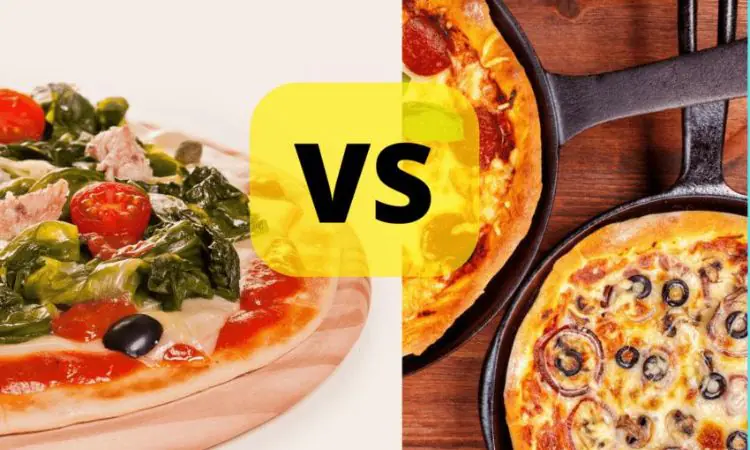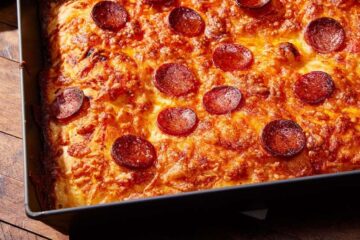Pizza Stone Vs Pan: A pizza stone allows for even baking, resulting in a crisper crust, while a pizza pan is not porous and may result in an undercooked crust if not regulated perfectly.

Credit: mama-cucina.com/
Advantages Of Pizza Stone
A pizza stone offers several advantages compared to a pan when it comes to making the perfect pizza. Using a pizza stone ensures that your crust is evenly baked, resulting in a consistent texture and taste throughout the entire pizza. Additionally, a pizza stone can give you a crispier crust, which is a desirable characteristic for many pizza lovers. Lastly, a pizza stone mimics the effect of a pizza oven, providing the necessary heat retention and distribution to achieve that delicious brick oven taste. Let’s delve further into each advantage.
Evenly Baked Crust
When using a pizza stone, you can expect your crust to be evenly baked from edge to edge. The porous nature of the stone allows it to absorb and distribute heat evenly, eliminating any hot spots that can result in an undercooked or overcooked crust. This ensures that every bite of your pizza has the same delightful texture and doneness.
Crispier Crust
One of the biggest advantages of using a pizza stone is the ability to achieve a crispier crust. The stone absorbs moisture from the dough, helping to eliminate any excess moisture and creating a crispier texture. The hot surface of the stone also promotes better browning, resulting in a beautiful golden crust that adds an extra layer of flavor and satisfaction to your pizza.
Mimics Pizza Oven Effect
Using a pizza stone in your oven can replicate the desired effects of a pizza oven. The stone absorbs and retains heat, creating a more intense and consistent heat source compared to a regular pan. This high heat helps to mimic the intense heat of a pizza oven, resulting in a perfectly cooked pizza with that distinctive crispness and charred flavor that is hard to achieve with other cooking methods.

Credit: www.amazon.com
Disadvantages Of Pizza Stone
The disadvantages of using a pizza stone compared to a pan include the cost and maintenance of a brick oven. Additionally, pizza pans are not porous, so the crust may remain undercooked if not regulated perfectly.
Although pizza stones are widely popular for their ability to produce crispy crusts, they do come with a few drawbacks. Let’s explore some of the disadvantages of using a pizza stone.
Cost
One of the major downsides of Pizza Stones is the cost. A good quality pizza stone can be quite expensive compared to a regular pizza pan. So, if you are on a tight budget, investing in a pizza stone might not be the best option for you.
Maintenance
Another disadvantage of using a pizza stone is the maintenance it requires. Pizza stones are delicate and can crack or break if not handled properly. Additionally, they need to be seasoned and cleaned regularly to ensure their longevity and prevent any buildup of residue or odors.
Undercooked Crust
While a pizza stone is great for achieving a crispy crust, it can sometimes lead to undercooked centers. The high heat conductivity of the stone may cause the crust to brown quickly while leaving the middle of the pizza doughy and undercooked. This can be a disappointment if you prefer evenly cooked pizzas.
Overall, while pizza stones have their advantages, it’s important to consider the potential disadvantages before making a decision. Consider your budget, maintenance capabilities, and desired crust texture when choosing between a pizza stone and a pan for your pizza baking needs.
Advantages Of Pizza Pan
A pizza stone offers the advantage of evenly baking the dough, resulting in a crispier crust. On the other hand, pizza pans are cost-effective and low maintenance but may result in undercooked crust if not regulated properly.
Cheaper Option
A pizza pan is a more budget-friendly option compared to a pizza stone. While a high-quality pizza stone can be expensive, a pizza pan is often more affordable and accessible. This makes it a great choice for those on a budget or for beginners who want to experiment with homemade pizza without making a significant investment.
Quicker Heating Time
Another advantage of using a pizza pan is its quicker heating time. Unlike a pizza stone, which requires preheating for a longer period, a pizza pan heats up rapidly, allowing you to start baking your pizza in no time. This means you can enjoy a delicious homemade pizza without the need to wait for the stone to reach the ideal temperature.
Disadvantages Of Pizza Pan
When it comes to baking pizza, using a pizza pan may not always be the best choice. While pizza pans have their advantages, they also come with a few disadvantages that can affect the overall quality of your pizza. In this article, we will explore the disadvantages of using a pizza pan, including limited heat absorption and less crispy crust.
Limited Heat Absorption
A major disadvantage of using a pizza pan is the limited heat absorption compared to a pizza stone. Pizza stones are made from materials like ceramic or cordierite that have excellent heat retention properties. This allows the stone to absorb and distribute heat evenly, creating a hot and consistent cooking surface.
On the other hand, pizza pans are typically made from metal materials like aluminum or stainless steel. While they conduct heat well, they do not retain heat as effectively as pizza stones. As a result, the heat distribution may be uneven, leading to unevenly cooked pizza.
Less Crispy Crust
Another disadvantage of using a pizza pan is that it can result in a less crispy crust. The limited heat absorption of the pan can prevent the crust from getting sufficiently crisp and golden. Crispy crusts are a hallmark of well-baked pizzas, and it can be difficult to achieve the same level of crispiness with a pizza pan.
A pizza stone, due to its ability to absorb and retain heat, can create a better environment for achieving a crispy crust. The stone absorbs moisture from the dough, allowing for a drier and crisper texture. This is especially important if you prefer thin-crust or Neapolitan-style pizzas.
In conclusion, while pizza pans have their advantages, it is important to consider their disadvantages as well. Limited heat absorption and less crispy crust are the two main drawbacks of using a pizza pan. If you want to elevate your pizza-baking game and achieve that perfect, crispy crust, investing in a pizza stone might be the way to go.

Credit: www.amazon.com
Frequently Asked Questions On Pizza Stone Vs Pan
Can I Use A Pan Instead Of A Pizza Stone?
Yes, you can use a pan instead of a pizza stone. A large cast iron skillet preheated upside down can replicate a pizza stone in the oven. Place it on a sheet pan for safety and ease.
Is It Better To Cook Pizza On Stone Or On Rack?
Cooking pizza on a stone results in a crisper crust due to even baking, while cooking on a rack lacks this advantage.
Does A Pizza Stone Really Make A Difference?
A pizza stone makes a difference because it absorbs and retains heat, resulting in a crisper crust. Unlike a pizza pan, a stone mimics the effect of a brick oven, providing an extra-hot surface to bake the pizza.
Is It Better To Cook Pizza On Steel Or Stone?
It is better to cook pizza on a stone rather than on steel. A pizza stone allows the dough to bake evenly, resulting in a crisper crust. On the other hand, steel heats slower and doesn’t last as long compared to stone.
Conclusion
To sum it up, both pizza stones and pans have their advantages. Pizza stones provide an even bake, resulting in a crispy crust. On the other hand, pans offer convenience and can replicate the effects of a stone. When choosing between the two, consider the desired crust texture and personal preference.
Whichever option you choose, remember to regulate the cooking process for the perfect pizza every time.

As the author of the “Ultimate Pizza Guide: Recipes, Tips & Secrets Revealed,” I’m dedicated to sharing my love for pizza and empowering others to create delicious homemade pizzas with ease. Join me on a journey to uncover the secrets to perfecting your pizza game!


